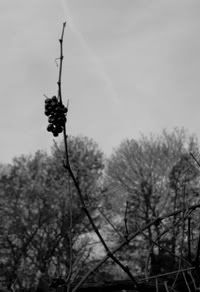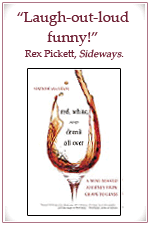Naar aanleiding van een Claude Terrand, Hautes Côtes de Beaune, 2002.
Ik geef mijn 'peert' dan al maar als eerste de sporen. Hieronder een pathetische verzuchting in het Flenglish naar aanleiding van een veelbelovende Bourgondiër, die alras een kat in een fles bleek:
This wine was one of the first Burgundies (even one of the first bottles of wine if I'm remembering rightly) I ever bought. No surprise then that it was with all my nitwitiness on wine I stumbled over it on the wine shelves of a local supermarket, one of those places commonly known to be the wrong go when it is going to be Burgundy in your glass. Yet, I did not open it right away, already having an inkling of some of the obligatory does and donts in Mondovino. It slept for I don't know how long in my cellar (not that long altogether; it's a 2002 vintage, so ... But then it's a Hautes Côtes). Having some Burgundy master classes finished one should feel more confident in opening and pouring a bottle of pinot juice, you'd say, but I am not quite sure about that. For one thing there is the inevitable truth that 'you know nothing when you drank nothing' (and that's certainly the case with me: lets count ... 120-140???). Something I am not worried about: just drink and you'll be fine, that's the way to go. Yet, there is another stark naked truth I don't feel so comfortable about: everybody knows how 'real' Burgundy or even better (read: worse) : how 'real' Pinot Noir should taste, yes! Yes ... ? What's up with this 'everybody' and 'should'? I don't like this creeping discursive poison. It's like profecying everybody has to confess this or that religion. Do we like that? No, certainly not.
What I wanted to say: what's all this mythmaking around 'real' Burgundy about? I just don't understand: everybody knows how a real one should look, smell, taste, feel, do I know what ... . But only a very small number of bottles get this label 'real' on their curvy bellies. Yeah, again a bad year, and yeah, this varietal is so difficult, yeah, ... . What about Nebbiolo then? Difficult grape, as difficult as Pinot Noir for sure, yet a 'true' Nebbiolo (call, it Barolo, Barbaresco, Valtellina, whatever you want) is much less rare. Take it from the other way round: Oregon, Californian, New Zealand and, yes, Northern Italian Pinots (ah, Silvio Morando) I often find much more interesting, tempting, even poignant. But, no, in every tasting you had these big-headed connoisseur fellows with their large noses stuck for hours in a glass (crap! your olfactory senses are numb after a few mins. in a glass, everybody sane knows that), who KNOW the real thing. Their choice? Boring, flat, stewed, sour and biting grape juices that have nothing involving (only this fancy stable stink, making us feel like real European peasants, should make up for a bit).
I'll tell you what's wrong, even when it's just 'not done' saying this: something is rotten in Burgundy land. And no, I don't mean the grapes. It's this image building that has gone completely over the top, the radicalness in modernising or not modernising their wines (Peynaud, Steiner, ... were either talking to a concrete wall or revered like gods) and most certainly the negociants' totalitarian power on the market. Everybody knows about the second reason. True, it is no real critique: somebody rise and claim 'they' 'should' modernise? I think not. Yet, the other two reasons are. About this imaging on its own we all know, and it's no real problem: taste, odour etc. are subjective judgements (I am not talking about the quality thereof, mind you), so we might be able to surpass that one. But, when you just link it with the last reason, it definitely IS a real problem. This is pure market fascism: you say what they think they drink and they drink what you say they think they drink. That's all: ideological oppression of your own senses. And the fact that 'real' Burgundies are the ultimate investors' wet dreams become liquid only adds up to the truth of this point. Heavens, a bottle of Romanée Conti gaveled for $14,200 ... .
Oh yes, there is still a bottle waiting to be reviewed. As I said before, I bought it in a local supermarket. I am not really sure about its price tag, but I think I spent some €13 on it (and that's well paid for a Hautes Côtes). Some of these 'connoisseurs' tipped me off about this one. And yes, I was looking for a nice, but not too expensive Burgundy. I am still a student and although I already drank some of these € 50-80 bottles, they are really no match for my wallet (btw: only a Barolo or some other Nebbiolo wine will drain my pocket for that amount). It should have been the right one to go for, they said. Oh my, the right one ... . A deep purple overextraction colour with virtually no reflection. Thin and quick legs. A fatigued nose of black cherry and maybe some cassis 'deepening' into black cherry and only black cherry after waltzing. When I sniff as if I would snort crack there seems to be some truffle and a smoky overtone. And it even gets worse: a watery mouthfeel with unpleasant sours. I certainly like some fresh and crisp sours (Nebbiolo and most Northern-Central Italian reds) in my glass as I am no 'call it dry, make it sweet'-style loving New World wine addict, but this is clearly one bridge too far. The palate isn't any better. Clear and pure impressions of black cherry and that's it. Some overtly oaky tannins and a very lovely and persistent touch of gastric juice in the aftertaste. Dull fruit, flat secondaries, uninvolving structure, not even well made. I'd long for a bottle of Oregon Argyle, a New Zealand Ata Rangi or an African Signal Hill for the same price, or even better (supreme): one of Morando's Neiró, for almost half a gap in my purse.
So lo and beware you chevaliers of taste! Someone into serious tasting should always be conscious of this discursive layer on his palate, I think. All right, we are not going to save the world, our children or our future doing so, but just think what a free palate might mean to you (your wallet and your partner's nerves), and you'll understand. The unbound, partly relativistic, yet physiological concept of organoleptic pleasure, is never to be an art of tasting when you are deprived of any authentic personal contribution to tasting discourse.


